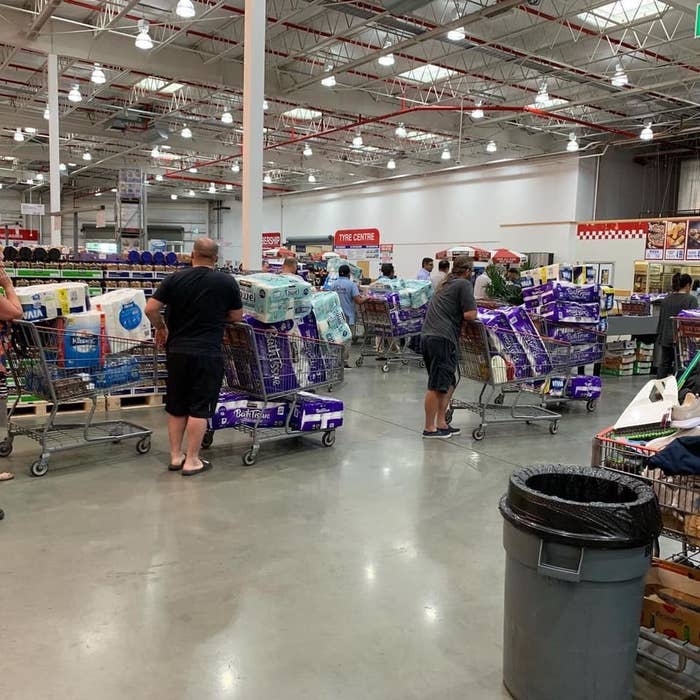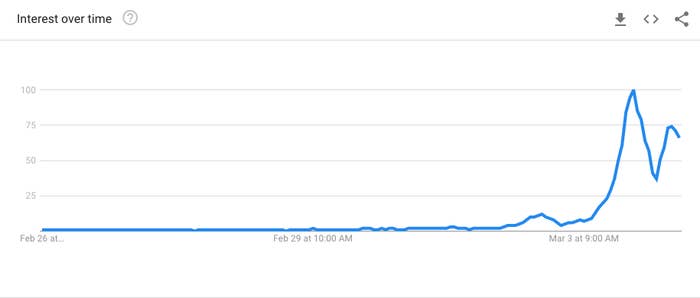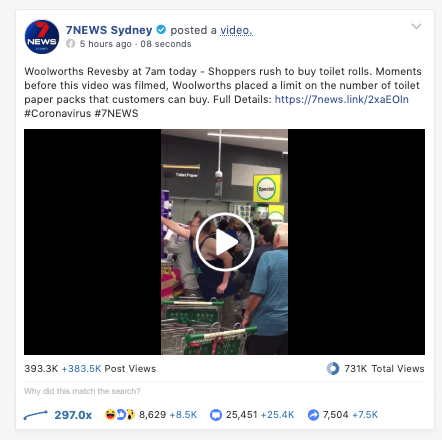
In response to the spread of COVID-19, there have been widespread concerns about how the virus will affect the world's supply chains. Shoppers around the world have begun to stockpile large amounts of goods such as masks, hand sanitiser and, notably, toilet paper.
In early February, supermarket shelves meant to carry loo paper in Singapore were empty. Armed robbers stole hundreds of toilet rolls in Hong Kong. Reports of shortages have come out of the US, Germany, Japan and New Zealand.
And — not long after the first Australian contracted COVID-19 domestically — toilet paper fever has hit Australia.
Google searches for "toilet paper" have skyrocketed.

Hashtags about the shortage have trended on Twitter since March 3.
@annestubbs What I think is hilarious right now is that #toiletpaper and #SurvivorAU is the number 1 and 2 trending topic right at this moment. At the rate this is going we may need to "Outwit, Outplay, Outlast" each other in a bid to get our hands on the elusive toilet paper.
And Australia's major news outlets are giving priority coverage to shortages.
@sicksadhack @_ClaireConnelly @stilgherrian @snurb_dot_info @TomSear @bencjenkins Just went on a coffee run and checked on the newspapers. Front page of SMH and Fin Review, double page spread in the Tele.
One of Australia's major supermarkets, Woolworths, is limiting toilet paper purchases per person. Police have reportedly attended an incident in the toilet paper aisle at a supermarket. Rolls are being marked up many times their original price on online classified sites. And Australians are sharing photographs en masse to social media of empty supermarket shelves.
But those in the know say there's no reason to panic buy toilet paper.
Tim Woods is the managing director of the Australian paper-product market analysis company IndustryEdge. He told SBS that stockpiling toilet paper is "completely unnecessary" as Australia produces two-thirds of its own toilet paper and has the capacity to produce more. Woods said that China — which is the largest global manufacturer of the product — is still moving on "several months supply".
So why are we all terrified of running out of the paper we use to clean our genitals?
It appears that among the most seen social media content about the toilet paper panic is coverage of the "toilet paper shortage" that doesn't explain there is no need to panic. And for the most part, traditional news organisations are the ones spreading this content.
Six of the top twelve performing Facebook posts about “toilet paper” over the past seven days were about the toilet paper shortage, according to data pulled from social media analytics site Crowdtangle at noon on Wednesday. Each of the six came from a social media account belonging to an Australian TV or radio station or news publication.
(The remaining six top "toilet paper" posts included videos of pets unfurling toilet rolls and a picture of a novelty toilet roll holder.)
The best performing "toilet paper" post over the past week is a short video published by 7NEWS Sydney titled "Shoppers panic-buy toilet paper at Woolworths in Revesby".
The post includes a link to an article that doesn't include any information about why there's no need to stockpile toilet paper. The video, showing pandemonium inside the supermarket, has been viewed more than 730,000 times and shared 7,500 times.

Only one of the six — an article posted by regional publication the Gold Coast Bulletin — explained why there is no need to stockpile toilet paper. Another post was just a meme about the shortage.
Across the internet, the top web content about Australia's toilet paper panic is a mix of real news reports and satirical articles, according to content analysis tool BuzzSumo (no relation to BuzzFeed).

Four of the top ten pieces of content are fake news articles from satirical publishers including The Shovel, The Chaser and Double Bay Today, which have nearly 100,000 Facebook engagements between them.
Out of the top five real news articles, only two explain why people shouldn't be worried about a toilet paper shortage.
The top article — "Toilet paper reaches Facebook Marketplace amid coronavirus panic-buying" — published on 7news.com.au does not dispel rumours of supply chain concerns. It's had more than 46,400 engagements on Facebook.
Neither Crowdtangle nor BuzzSumo indicate any viral posts from individual users — as opposed to media outlets — among their top performing posts.
Anecdotally, people have reported seeing numerous posts from family and friends about the toilet paper crisis, but none of these individual accounts have a reach comparable to traditional media organisations.
My fb feed is full of pics of empty shelves. My friend just posted this from one of the 4 supermarkets near me. And they're all are like this.
Professor Axel Bruns is a social media and journalism researcher at Queensland University of Technology. Bruns told BuzzFeed News that analysis of a list of about 1,400 fake news domains revealed that there's no "genuine" disinformation campaign pushing toilet paper panic in Australia.
Instead, he blames it on mainstream media uncritically elevating accounts of shortages from social media.
There is no panic buying in the bush. If things get pointy and you city slickers try and head west to steal our stash, we'll block the bloody roads. No-one gets in without an electricity bill + Woolies, Coles, Aldi, IGA and Kebab Meat trucks. #coronavirusaustralia #panicbuying
"Mainstream media are amplifying the Twitter discussion, possibly without much verification," Bruns wrote in a message. "And of course social media then re-amplifies the mainstream coverage."
Bruns said that a combination of social media and traditional media coverage can create a sense of panic, even when there's no threat. He believes that social media content is "validated" in the eyes of the audience when it's picked up and covered by mainstream media.
"Mainstream media coverage implies at least in theory that the content has passed through a more stringent gatekeeping process," he wrote. "That's no longer necessarily true, though, especially for clickbait news. So journalists should be cautious about how they report these trends, even though they might just seem funny."
